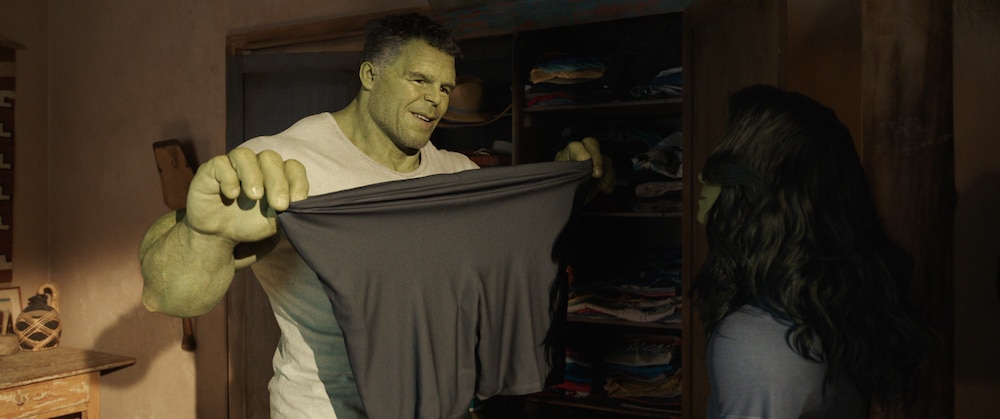Create a free profile to get unlimited access to exclusive videos, sweepstakes, and more!
The science behind She-Hulk's (and other superheroes') stretchy super suits
The greatest superpower in the MCU? One size fits all.

A recent episode of She-Hulk: Attorney at Law introduced audiences to an unsung hero of the Marvel universe: the tailor responsible for making all the superpowered threads. Being a superhero, it seems, requires a change of wardrobe to suit your new lifestyle. You want something with brand appeal, of course, but it should also be functional. In She-Hulk’s case — not to mention a whole host of other heroes including Mr. Fantastic and the OG Hulk — that means being stretchy while still being strong. Marvel movies are rated PG-13, so we can't have superpowers shredding clothes and leaving a hero super-naked. That's where stretchy clothes come in.
We know the Marvel universe isn’t limited to the materials we find on our version of Earth, but what if they were? Is it possible to make a super suit suitable for all of your hulking needs using only materials we find here at home?
HOW MUCH DOES IT HAVE TO STRETCH?
Before we can get into which materials might or might not do the trick, we first need to figure out exactly what we need it to do. The primary goal of all clothing, whether for metahumans or normies, is to cover our shameful bodies while we’re out and about. Ordinary clothes fail at the outset, just as soon as Jen, Bruce, or Reed change their size. Sure, they could wear incredibly baggy clothes in anticipation of an eventual transformation, but both fashion sense and science insist they don’t. The question is then, how much stretch do we actually need?
Note: these values will obviously change depending on the hero and even which iteration of the character you’re looking at. We’re dealing with fictional characters; approximations are probably good enough. According to Marvel Database, a fan-driven but comprehensive resource, Jennifer Walters stands 5 feet 10 inches tall, although there is some dispute about that. When she’s She-Hulk, however, she sprouts to 6 feet 7 inches. Using those values, we can estimate the volumes a super suit would need to address.
The good news is that’s not a lot of expansion. We’re looking at a total of 9 inches in vertical rise spread out over the rest of the body. That’s only a twelve percent increase in height and is actually within the capabilities of fabrics we use all the time; you may even have some in your closet.
Spandex may have hit its peak in the 1980s but it’s still an ordinary part of our wardrobes today in subtler ways. Even today, a significant portion of the clothing purchased in the United States contains spandex. That’s because it’s incredibly good at stretching, something which is important even for ordinary humans as our bodies change shape over time. We’re all sort of going through our own She-Hulk transformations, just more slowly and with less fame.
Of course, ordinary clothing with just bits of spandex in them might not do the trick for Jennifer Walters. We might be forced to feather our hair, break out the legwarmers, and fall in love with the spandex suit again. Spandex is capable of stretching to twice its original size when it needs to and still return to its original shape.
As gauche as a spandex suit might be, it succeeds at accomplishing the primary mission objective of clothing. It stays where it’s supposed to be and isn’t destroyed if the wearer suddenly becomes 12 percent larger. However, spandex isn’t necessarily the best at protecting your body or itself from death rays, intelligent AI, or Titania’s right hook. For that, we’ll need material that’s a little more exotic.
INVENTING NEW MATERIALS
Making your super suit out of materials that are readily at hand is nice, but what can we achieve when we really put our minds to it? In 2012, scientists set out to create a new material which incredible strength. They settled on an artificial hydrogel made of alginate from the cell walls of algae, a polymer called polyacrylamide, and water.
Hydrogels are, by their nature, good at handling external forces. They stretch and deform, then return to their original shape, as long as the force isn’t too great. According to Live Science, contact lenses — which are themselves hydrogels — can withstand a few hundred joules per square meter of force before they break. Your own cartilage can withstand about 1,000 joules. The material scientists crafted can stand up to forces ten times that of cartilage hundreds of times more than a contact lens.
For comparison, the average human punch generates about 150 joules of force. Your nemesis would need to be dozens of times stronger than a typical human before you’d even need to worry about wrinkles. That’s to say nothing about the flesh beneath the clothes which could still be pummeled to bits. Tread carefully.
The material’s capabilities don’t end there. While researchers didn’t set out to make their material stretchy, it was incredibly flexible. Their hydrogel material could stretch roughly twenty times its original size without permanently deforming. What’s more, even if it does deform due to overstretching, you can recover its shape by heating it to 176 Fahrenheit or 80 Celsius.
Algae-based hydrogel super suit it is. Now we just need the MCU’s star tailor, Luke Jacobson, to help us make it look cool.



























